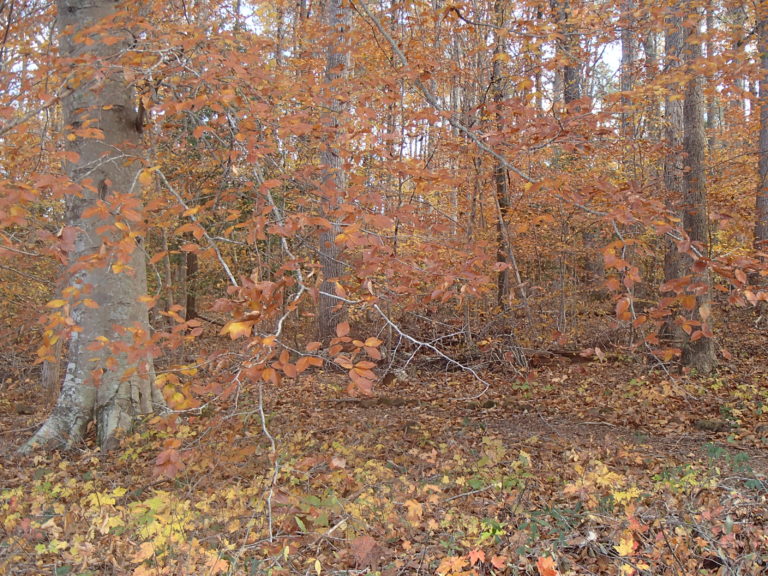American Beech is one of the most beloved trees of Eastern North America, a late-successional tree reported in many counties of NC from the mountains to the coast. It is a medium to large tree, growing usually to 80 feet (but observed also at 100 feet tall or more), and can spread between 40 to 70 feet. The bark is very smooth, silver gray, with occasional characteristic lesions. American beech can be easily identified in the winter by its bark, its elongated, pointy vegetative buds with overlapping scales, and its tendency to hold its leaves well into the winter on the juvenile parts of the tree (proximal stems). Beechnuts are edible by people and constitute an important part of the diet of a large number of mammals and birds. Trees usually begin bearing seeds at around 40 years, with a total life span of more like 300 years. American Beech leaves are oval, bright green and shiny in summer, turning shades of gold in fall. It is a climax species that grows slowly underneath an overstory of conifers or hardwoods, eventually ascending into the overstory. Suckering is an important part of its reproductive strategy in the wild.
NURSERY HOURS
Wednesday: 10-4 Thursday: 10-6 Friday-Saturday: 10-4 Sunday: 12-4
Fagus grandifolia

Key Info
Scientific Name: Fagus grandifolia Ehrh.
Common Names: American Beech, White beech, Red Beech, Ridge Beech, Beechnut tree
Family Names: Fagaceae (Oak and Beech Family)
Plant Type: Tree / Shrub
Leaf Retention: Deciduous
Flower Color: Yellowish green, Inconspicuous
Special Characteristics: Good wildlife cover/habitat, Tolerates Black Walnut, Interesting bark, Good fall color, Rhizomatous, Reported to be deer resistant.
Additional Info
Habit: Beech grows with a dominant central stem with low branches. Branches are stout and horizontal below, ascending above, forming a dense, round crown. Bark is smooth, light grey/silver, and roots are shallow and fibrous.
Height: 50'-80'or more
Spread: 40'-60'
Soil Conditions: Deep, rich, moist but well-drained soils; intolerant of wet, poorly drained soils. pH acid to circumneutral; sandy loam, clay loam, medium loam.
Leaves: Alternate, simple, oval-elliptical, 3 to 5 inches long, pinnately-veined with each vein ending in a sharp, marginal distinct tooth. Leaves are shiny green above, very waxy and smooth, slightly paler below (Va Tech); leaves turn brownish copper and remain on tree into early winter.
Flowers (or reproductive structures: Monoecious; the male flowers in drooping, long-stemmed, globular clusters and the female flowers borne on shorter spikes, appearing just after leaves in the spring.
Fruit: Seeds, which are edible, are smooth, triangular, shiny brown, found in pairs within a woody, spiney husk 1/2 to 3/4 inch long, maturing in the fall. Fruiting occurs September/October and seeds are released October/November after frost.
Natural Distribution: Moist lowland areas, rich open woods
USDA Hardiness Zone: 3 to 9
USDA Wetland Indicator Status in NC: FACU
Pollination: Wind
Wildlife Connections: In addition to humans, the nuts are eaten by small and large mammals, (rabbits, squirrels, white-tailed deer, black bears, porcupines, raccoons, foxes); birds (ruffed grouse, wild turkeys, ducks, pheasants, woodpeckers, white-breasted nuthatches, American crows and blue jays). Leaves also support lipidopteran caterpillars, and the tree provides nesting habitat for many birds.
Propagation: From seed (there is a cycle of heavy seeding every 3 years; don’t allow seeds to dry out as this drastically reduces viability.)
